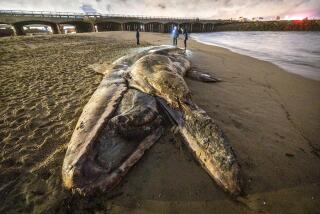‘Dead zone’ tied to climate change
- Share via
CORVALLIS, ORE. — An oxygen-depleted “dead zone” the size of New Jersey is starving sea life off the coast of Oregon and Washington and will probably appear there each summer as a result of climate change, an Oregon State University researcher said Thursday.
The huge area is one of 400 dead zones around the world, most of them caused by fertilizer and sewage dumped into the oceans in river runoff.
But the dead zone off the Northwest is one of the few in the world -- and possibly the only one in North America -- that could be impossible to reverse. That is because evolving wind conditions likely brought on by a changing climate, rather than pollution, are responsible, said Jack Barth, professor of physical oceanography at OSU.
“I really think we’re in a new pattern, a new rhythm, offshore now. And I would expect [the low-oxygen zone] to show up every year now,” Barth said at a news conference.
Thursday’s briefing coincided with the release of a National Science Foundation multimedia report that said the number of dead zones worldwide was doubling every decade.
In the Pacific Northwest, the report said, the areas of hypoxic, or low-oxygen, water that long have existed far offshore began to appear closer to land in 2002, a phenomenon that may mean they are even deadlier to sea life that exists near the ocean floor.
Low-oxygen zones are created when large blooms of plankton form on the surface of the ocean, then decay and fall to the sea floor, where further decay eats up the oxygen in the water.
“When oxygen gets too low in the ocean, it has a deleterious effect on organisms,” Barth said. “They either have to flee the area, or they get stressed or even die off. Those die-off [areas] are dead zones.”
The affected waters of the continental shelf in Oregon and Washington for the most part are not inundated with polluted river runoff; the nutrients that feed the plankton blooms here come from natural sources, Barth said. And researchers believe a change in the flushing movement of water along the coastline may be responsible.
The gradual warming of surface waters across the north Pacific, the report funded by the National Science Foundation said, has tended to isolate deep waters far below the surface -- allowing less oxygen penetration.
There also has been a change in wind patterns, encouraging the upwelling of that low-oxygen water and inhibiting the natural flushing action of water.
“What we’re seeing is changes in the oxygen content of the water and the winds that drive the ocean and cause that flushing,” Barth said, calling it a “double whammy.”
Although it is possible that the phenomenon could be related to cyclical ocean currents and temperatures, Barth said that he was more inclined to believe it was a long-term result of climate change. He said that researchers had scanned records going back to the 1950s and had seen nothing similar to what has appeared every year off the Oregon coast since 2002.
The worst year on record was 2006, when the Pacific Northwest zone saw an area of “anoxia,” or virtually no oxygen at all.
--
More to Read
Sign up for Essential California
The most important California stories and recommendations in your inbox every morning.
You may occasionally receive promotional content from the Los Angeles Times.










